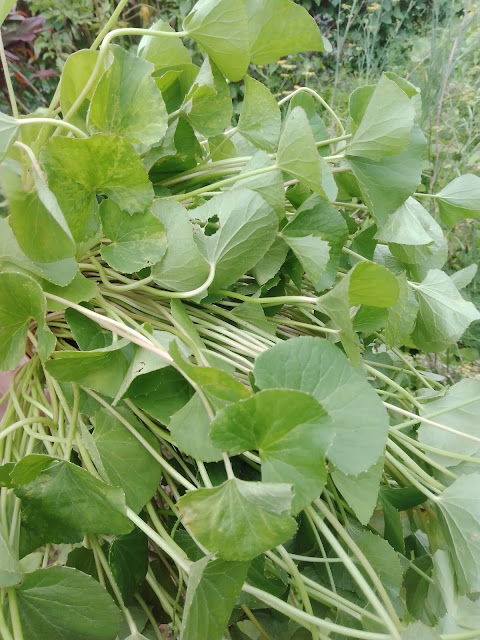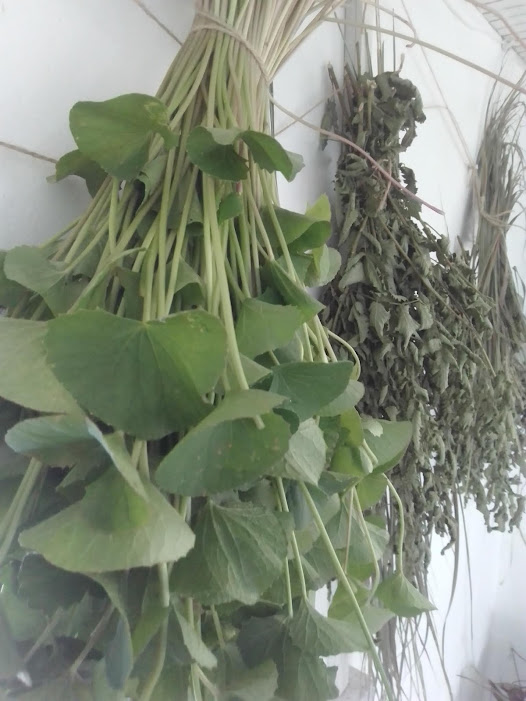About three years ago I had no idea of something named "Gotu Cola" or sometimes spelt with Kola, until one day a foreigner in Dominica showed me a picture from her phone and asked me if I knew this herb and if I could get some for her. I remember telling her these words "I am good at finding plants so let me see"..that same week someone else asked me to get them some roots that they dreamed about.. I felt as if something special was happening and that I'd find reason in due time. Am I born for this?
A couple days after I was out collecting Dandelion roots from a cliff in the village and there I saw Gotu Cola for the first time . It must have been there for years for how the ground where it was growing looked. I took a portion to plant in my garden and also I started my research online and locally. This is what I found; Gotu kola has been used in Asia for thousands of years, both as a medicine and as a leafy vegetable. It is first mentioned in the historic ‘Sushruta Samhita’, one of the earliest Ayurvedic medical texts compiled around 300 C.E. This luscious green herb is a favourite to help improve mindfulness and is said to revitalise consciousness and maintain youthful wit. Source: https://apa.uk.com/herb-of-the-month/gotu-kola . After reading this I continued to research more about Gotu Cola and I also introduce it to my customers and anyone that wants to learn about healing plants and herbs as a
"Must Have!" Nonetheless I realize that some people do have knowledge of the plant and its uses as I venture with Gotu Cola plants for sale. Mostly foreigners though.
The leaf has a few signatures that cannot be missed. The doctrine of Signatures refer to what a plant looks like. The disease, organ, or person it can heal.Thus, the shape, color, sensory impression, and habitat all can be used to determine the uses of a plant.
Looking at the picture above we see how the Gotu Cola (Centella Asiatica) leaf is shaped like a Brain, has veins, and although the plant creeps low and roots onto the ground but the stalks and the leaves stand upright like a strong head firmly sitted on the neck that supports it. Sometimes leaves even look like a kidney. If you see any other signatures, please leave a comment!
In traditional Chinese medicine, Gotu Cola is believed to promote longevity and is considered a potent elixir of life. In fact, its Chinese name means “fountain of youth.”
Legend has it that herbalist and martial arts master Li Ching-Yuen lived to be 200 years old (more or less) in part due to the longevity-promoting benefits of gotu cola.
A Sri Lankan legend says that elephants live exceptionally long lives because they eat lots of gotu cola.
" In human studies, gotu cola increased calmness, contentedness, and alertness by 100% and significantly reduced symptoms of anxiety and depression. Source: https://bebrainfit.com/gotu-kola-benefits-brain/
The poster above lists 7 top benefits of using gotu cola . You can always read some more from other sources to broaden your knowledge on the benefits of using this legendary and ancient plant.
What most strikes me is the fact that it also contributes to the formation of new braincells similar to Rosemary! See the post on Rosemary vs WIFI https://tuherbicina.blogspot.com/2016/07/rosemary-vs-wi-fi.html
Ways to use Gotu Cola
Harvest fresh bundles for juicing . See the youtube video below for instructions
on How to Juice Gotu Cola.
Gotu cola makes an excellent ground covering for uncultivated garden areas
Dry some to keep inside for making tea!
We sell Gotu Cola Teabags @ tuherbicinaplantshop767 *Labels under construction*
We sell Gotu Cola Plants @ TUHERBICINAPLANTSHOP767 for $10ec
Contact for Prices and Delivery/ Shipping Information:
WhatsApp: 1 767 276 6080
Join WhatsApp group
@TU HERBICINA










Comments
Post a Comment